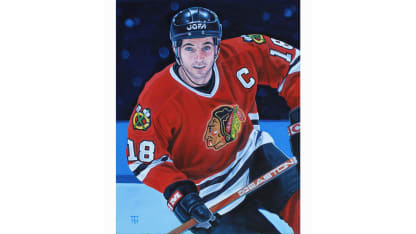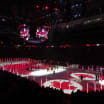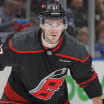As part of the NHL Centennial Celebration, renowned Canadian artist Tony Harris will paint original portraits of each of the 100 Greatest NHL Players presented by Molson Canadian as chosen by a Blue Ribbon panel. NHL.com will reveal two portraits each Monday in 2017 and two on Friday, Aug. 11, 25 and Sept. 8.
This week, the portraits of centers Joe Sakic and Denis Savard are unveiled in the 30th installment.
Sakic, Savard portraits unveiled
Color paintings of 100 Greatest NHL Players will be revealed on NHL.com on select Fridays in 2017
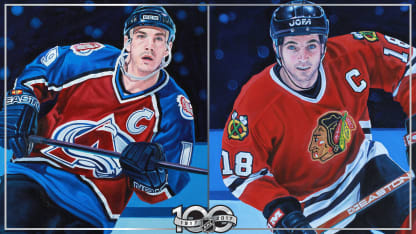
By
NHL.com @NHLdotcom
In his 20-season, Hockey Hall of Fame NHL career, Joe Sakic captained the Colorado Avalanche to two Stanley Cup titles, and had 625 goals and 1,016 assists. His 1,641 points rank him ninth all-time.
Sakic, selected in the first round (No. 15) by the Quebec Nordiques in the 1987 NHL Draft, moved with the franchise to Denver before the start of the 1995-96 season and helped lead the Colorado Avalanche to the Stanley Cup that season. He had 34 points (18 goals, 16 assists) in 22 games to win the Conn Smythe Trophy as MVP of the Stanley Cup Playoffs.
The Avalanche won the Stanley Cup for a second time in 2000-01. Sakic led the way again, with 118 points (54 goals, 64 assists) and 12 game-winning goals in the regular season to win the Hart Trophy as the League MVP.
One year later, he helped lead Canada to the gold medal at the 2002 Salt Lake City Olympics, where he was named tournament MVP. He also won gold for Canada at the 1988 IIHF World Junior Championship and the 1994 IIHF World Championship.
Sakic also helped Canada win the World Cup of Hockey in 2004.
In his NHL100 profile
of Sakic, author Wayne Coffey wrote about how unselfish and outstanding a player he was:
"Sakic was the sort of superstar who not only didn't seek out glory and acclaim for himself, but went out of his way to spread it to others. When the Avalanche captured their second Stanley Cup title five years after the first one, one of the most enduring images was of Sakic being handed the Stanley Cup by NHL Commissioner Gary Bettman, then immediately turning it over to teammate Ray Bourque, who had waited 22 NHL seasons for that moment.
"That 2000-2001 season would be the pinnacle of Sakic's NHL career. His 118 points (54 goals, 64 assists) and 12 game-winning goals helped him with the Hart Trophy as League MVP, and his class helped him win the Lady Bing Trophy as the League's most gentlemanly player.
"One year later, Sakic was back at it, leading Canada to the Olympic gold medal with a victory over the United States in the finale of the 2002 Games in Salt Lake City. Sakic was named tournament MVP, and it was no surprise to Canada's coach, Pat Quinn.
" 'I will always remember how outstanding he was,' Quinn said. 'You are scared sometimes -- as a coach, you are scared about things in the game -- but I remember thinking I was never going to take Joe off the ice. He was making the right decision all the time. He scored two big goals. He was just the outstanding player on the ice.'
"Winning had a way of following Joe Sakic around. A very small club of players can claim to have won the Stanley Cup twice along with a gold medal at the World Junior Championship, World Championship and Olympics, and have won the World Cup of Hockey.
"About the only thing that didn't work out as Sakic had hoped was when the Winter Games came to his backyard, Vancouver, in 2010. At age 40, Sakic had missed most of the previous two seasons because of back injuries and a snowblower accident that cost him even more time.
" 'I always said to myself that the minute I thought I'd slipped, and not be the player I wanted to be, it was time for me to go,' Sakic said."
Artist Tony Harris said seeing Sakic in an Avalanche uniform took some getting used to:
"I remember when Quebec moved to Denver and how different their new uniform was," he said. "It took me a while to get used to it. But after watching Joe Sakic lift two Stanley Cups, it looked pretty good."
Denis Savard played 17 seasons in the NHL, 13 with the Chicago Blackhawks, who he helped become relevant again in the 1980s.
Taken with the third pick in the 1980 NHL Draft, Savard made an immediate impact with 28 goals and 47 assists in 1980-81. His 75 points were the most ever by a Blackhawks rookie.
One season later, Savard had 32 goals and 87 assists -- the most in Blackhawks history -- for 119 points. Only Bobby Hull, with 107 points in 1968-69, had achieved triple digits with the Blackhawks. Savard again had 87 assists in 1987-88, when he set a Blackhawks record with 131 points. Savard partnered with Al Secord and Steve Larmer to form one of the League's most dangerous lines, and the Blackhawks became a staple in the Stanley Cup Playoffs. They reached the third round in 1982, 1983, 1985, 1989 and 1990.
But three times during that stretch the Blackhawks were eliminated by the Edmonton Oilers, and Savard never won the Stanley Cup with Chicago. On June 29, 1990, he was traded to the Montreal Canadiens for defenseman Chris Chelios and a second-round pick in the 1991 NHL Draft. He would win the Stanley Cup with the Canadiens in 1993.
Savard joined the Tampa Bay Lightning for the start of the 1993-94 season but was traded to the Blackhawks at the 1995 NHL Trade Deadline. Savard, who played in the NHL All-Star Game seven times, retired after the 1996-97 season with 1,338 points (473 goals, 865 assists) in 1,196 NHL games. Savard's No. 18 jersey was retired by the Blackhawks on March 18, 1998, at United Center.
Savard ranks third all-time on the Blackhawks regular-season scoring list with 1,096 points, behind Hull (1,153) and Stan Mikita (1,467), and second in the playoffs with 145 points, behind Mikita (150).
In his NHL100 profile
on Savard, author Bob Verdi wrote about a memorable All-Star Game in Chicago when Savard was a member of the Canadiens and the skill that made him so dangerous:
"In 1991, he was a late injury replacement for the Wales Conference at Chicago Stadium. [Blackhawks owner Rocky] Wirtz, an ardent Savard admirer, publicly lobbied for the former Blackhawks superstar. When Savard took the ice for the warm-up, he was given a long standing ovation.
"'I was sick as a dog that week,' Savard said. 'If it was anywhere else, I wouldn't have made it. But I had a special feeling for Mr. Wirtz, the Blackhawks and their fans. As it was, I couldn't even finish the game. I left in the third period, and spent the next two days in bed with the flu or whatever it was.'"
"When Savard could not find room to maneuver, he created space through sheer ingenuity. He had the spin-o-rama down pat. A right shot, Savard would switch the puck to his backhand, buttonhook around in clockwise fashion, then fire on a goaltender while the adversary who thought he had this dynamic icon in-check wondered what happened. Just when you figured you had Savard covered, he went thataway. He was fluid and explosive. On Jan. 12, 1986, against the Hartford Whalers, he scored four seconds into the third period, tying the NHL record for fastest goal after the start of a period.
"'Reminds me of Mikita, and that's high praise,' Hull said. 'A lot of the same moves and vision.'"
Harris said he's been a fan of Savard since the day the Blackhawks drafted him.
"I grew up a Blackhawks fan and when they drafted Dennis Savard I was ecstatic," he said. "He played with the passion of a kid and that joy is what I hoped to capture in his top 100 portrait."
Joe Sakic
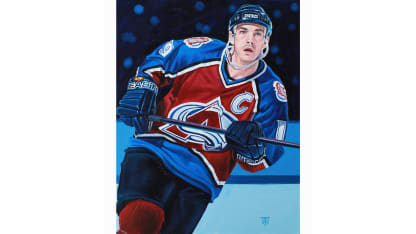
Denis Savard
